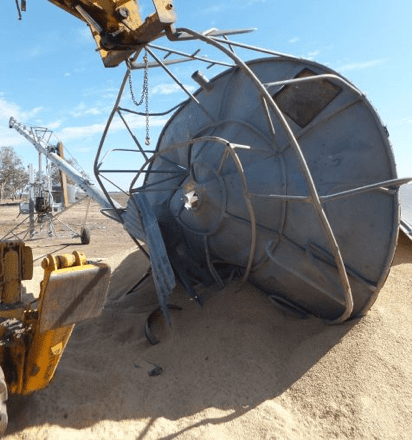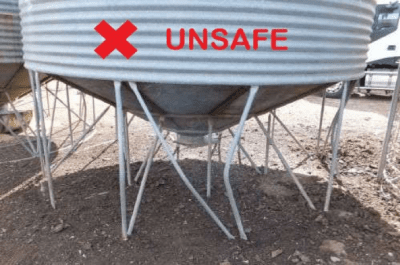
AS NATIONAL Farm Safety Week is marked across Australia, a warning has been issued about the dangers of working with transportable silos following a recent on-farm accident in Queensland.
 In May 2020 an RACQ LifeFlight Rescue helicopter from Toowoomba flew a critically injured Goondiwindi farmer to hospital after he was crushed by a grain silo.
In May 2020 an RACQ LifeFlight Rescue helicopter from Toowoomba flew a critically injured Goondiwindi farmer to hospital after he was crushed by a grain silo.
The man, aged in his forties, had been working under the five metre-high silo attempting to position a grain auger and release the slide gate (knife plate) on the discharge cone when it unexpectedly collapsed, trapping him beneath.
A workmate was able to raise the alarm.
A WorkSafe Queensland report into the accident said it appeared the support framework buckled on one side of the silo, causing the body of the silo to topple sideways onto the ground.
The impact with the ground caused the skin of the silo to tear away from the silo base, spilling grain onto the ground.
The farmer was trapped for some time until he could be removed.
In addition to being severely injured, there was also a risk of the farmer being engulfed (i.e. suffocation risk) in the grain as it emptied from the ruptured silo.
He was flown to the Princess Alexandra Hospital, in a critical condition, under the care of an RACQ LifeFlight Rescue Critical Care Doctor and a QAS Flight Paramedic, Despite his injuries the farmer survived and has since undergone a number of surgeries to aid his recovery.
The WorkSafe Queensland report said the cause of the failure is currently being investigated but so far it has not been determined why the support framework failed.
This photograph shows the buckled support frame after the collapse:

Failed silo support frame.
Worksafe Queensland said support frames on silos can fail for one or more of the following factors:
-

Damage to support frame and bottom ring has sunk into the ground. Bottom ring will corrode.
Damage, including bent support members and broken welds. Bending not only reduces the load carrying capacity of a member but can also increase the load applied to that member because it can cause the silo to tilt, therefore moving the centre of gravity closer above the member (Photograph 2).
- Impact from mobile plant—this can cause immediate collapse or can bend support members so that failure can occur later.
- Corrosion—either external or internal corrosion. Internal corrosion can occur when hollow members fill with water, even with small cavities in the member and no drainage holes. External corrosion can occur when the protective coating degrades or when parts of the support frame are buried in dirt (Photograph 2).
- Soft or sloping ground under the silo can cause the silo to tilt, making the silo unstable and increasing the load on some of the support members.
- Poor design and/or manufacture.
- Poor repairs.
It noted that transportable silos are generally designed to be lightweight to allow easy movement.
This characteristic means that this type of silo can be blown over when it is empty and not anchored to the ground or support pad.
The lightweight design of the silo means that damage from being blown over is certain to occur.
In the wake of the incident Worksafe Queensland has issued a safety alert to highlight the risk of collapse of transportable (relocatable) silos, commonly used on farms.
Silo installation
Silos must be set up in accordance with the manufacturer’s instructions.
The safety authority’s advice is to ensure silos:
- have been designed and manufactured to allow for all load combinations during their lifecycle including loads that are applied during filling, storage, discharge and as a result of environmental factors (e.g. high winds)
- are preferably set up on level concrete pads and/or footings that can safely support the load when it is full. If the silo is set up on ground, point loading needs to be spread so that the bearing pressure does not exceed the bearing capacity of the ground (e.g. to avoid the silo falling over, particularly after rain). Information on suitable dunnage or pads under the silo should be requested from the silo manufacturer, or a suitably qualified engineer
- are anchored to the supporting surface in accordance with the manufacturer’s instructions to avoid the silo moving or overturning in strong winds when empty
- are only filled with product that has been approved by the silo manufacturer. A silo designed for grain may not have the same corrosion resistant properties of a silo intended for fertiliser. In addition, the density of some fertilisers may be far more than that of grain (i.e. in some cases fertiliser density can exceed 1.4 tonne/m3 while some grains have a density of only 0.6 tonne/m3). Filling a silo with heavy product may lead to failure of the silo and its support frame
- are set up where they are unlikely to be damaged by mobile plant and in areas away from overhead power lines
- are periodically inspected for damage and corrosion.
Damage to support frames
Silos with damaged support frames should be isolated from workers.
Repairs to damaged support frames should not be carried out unless the silo is empty, as the repair procedure can increase the risk of failure.
Do not allow anyone under a full or partially filled silo with damaged framework, unless the silo has been safely propped. Information on appropriate temporary propping should be obtained from the silo manufacturer or a competent person such as a suitably qualified engineer. A safe system of work needs to be implemented to ensure that no workers are at risk when installing the props. This includes ensuring workers do not get underneath the silo to install the props and the propping method does not increase the risk of collapse (i.e. if the props are overtightened so that increased loading occurs on the opposite side of the silo).
Once the safety propping has been installed, workers can get under the silo so that it can be emptied1. Once the silo has been emptied it should be repaired in accordance with the silo manufacturer’s instructions. A damaged silo should not be refilled.
The Worksafe Queensland report added that a silo designed with a discharge gate that can be activated so that the operator is not located underneath the silo is preferred.
National Farm Safety Week runs from July 20-25.
For more details click here

HAVE YOUR SAY